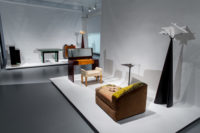Rarely does a museum show bring the shock of discovery to a familiar topic. Rarer still, when we have studied the subject, even immersed ourselves in its manifestations, and inculcated its lessons in our own worldview. Bauhaus 1919—1933: Workshops for Modernity, an exhibition that debuted at the Museum of Modern Art in New York on November 8 and runs through January 25 (a different version was on display earlier this year in Berlin), orchestrates a coup: We see the familiar Bauhaus through refreshed eyes.

Every architect knows the fundamentals, how Walter Gropius devised a school that combined the visual arts in a transforming way, establishing not studios but workshops that had social and cultural goals beyond the mere aesthetic. In a period of rapid technological advancement, set in the days of the Weimar Republic, the school had profound implications in the development of notions of the Modern. We feel its effects today — in architecture, interior design, industrial design, and other disciplines. Yet for all our intellectual knowledge, until this show, many of us had not confronted the Bauhaus viscerally, not felt its freshness or its spirit of inquisitive experimentation or its tangible sense of power and joy.
Now we get it. In structural terms, the curators have organized the exhibition into three parts, which correspond to the institution’s three physical locations in Germany (Weimar, 1919—24; Dessau, 1925—32; and Berlin, 1932—33), which in turn roughly correspond to three directors (Gropius, 1919—28; Hannes Meyer, 1928—30; Ludwig Mies van der Rohe, 1930—33). In the galleries, a wealth of work from each period by a who’s who of talented midcentury artists, craftspeople, architects, and other designers shares center stage with student work.
The artifacts, overwhelming in diversity and richness, seem immediate in their apparent newness. Space after space offers up a variety of media, from bookbinding and printmaking to industrial and furniture design. Ultimately, the exhibition’s primary lesson must be how one school, for a relatively short period of time, engendered so much excitement and high accomplishment within the visual arts. For anyone who has ever taught architecture, or any student of architecture, the exhibition humanizes and makes approachable work that has risen to canonical status.
Inevitably, we are struck by the individual objects, which draw us through the spaces like magnets. Here, we encounter the rhythms and harmonies of Vasily Kandinsky (concurrently featured in a retrospective exhibition at New York’s Guggenheim Museum, through January 13), creating internal cosmic music within two dimensions, in canvases such as On White II that retain the power to engage us, to plunge us into his world, to electrify and shock us. There, mounted on the wall, we face the shimmering textiles of Gunta Stolzl and Anni Albers — geometric, measured, pieced, woven, and textured. Glowing ahead, the multicolored stained-glass compositions of Josef Albers, which, though small, draw us closer with gravitational strength. And concentrated and vast, though tiny, the drawings and paintings of Paul Klee force us to approach, breathe, and dive through the looking glass.
Surprise lurks from spot to spot. Earthenware by Marguerite Friedlaender and Otto Lindig has the immediacy and forcefulness of archaic Greek pottery. Puppets by Paul Klee jump into three dimensions. László Moholy-Nagy’s photographs pull us directly into the picture plane, with their asymmetrical, immediate perspectives. His unanticipated constructions, like the Dada-esque Lichtrequisit einer Elektrischen Bühne (Light Prop for an Electric Stage), which is an idealized, even Platonic contraption, could have made Duchamp blush.
Bauhaus works of industrial and furniture design, now part of our everyday lives, were intended to be catalytic, to reflect and to change ways of living, by creating objects that could transition from handcraft to manufacture. Marcel Breuer’s tubular steel chairs have become ubiquitous, a fact presaged and encouraged by the first ambitious Bauhaus show, staged by MoMA in 1938, designed by former Bauhaus student and instructor Herbert Bayer, and organized by Gropius himself. Other furnishings, such as a sinuously folded newspaper shelf by Gropius from 1923, resonate in the work of today’s architects: The shelf looks like a cover from a recent issue of Architectural Record.
Walter Determann’s ambiguous, brightly colored drawing walks the line between architectural delineation and fine art; only after reading the descriptive text do we realize that this rendered, stylized icon incorporates an architectural scheme (site plan for Bauhaus-Siedlung, or Bauhaus housing settlement). The patterned plan unfolds more clearly when placed in the context of its accompanying elevations for administration and exhibition buildings. On leaving, we dance with another mind-game, in a photograph that presages Photoshop. Eduard Ludwig’s Renovation of the Borchardt Department Store, Dessau, actually a photograph with drawn and painted additions, mounted on plywood, resembles MoMA’s own 1938—39 International Style building by Philip S. Goodwin and Edward Durell Stone. The circle is complete.
In mounting this retrospective of the Bauhaus 90 years after its founding, the Museum of Modern Art — thanks to Barry Bergdoll, its chief curator of architecture and design, and Leah Dickerman, curator of painting and sculpture — returns to its essential Modern roots. More tellingly, the forever-young character of the exhibition demonstrates how the members of one small, experimental school in Germany have influenced a century. Despite the subsequent chastening of the 20th century, their enthusiasm for the power of the arts and the potential they unlocked carries on.
If you wish to write to our editor-in-chief you can email him rivy@mcgraw-hill.com.


Post a comment to this article
Report Abusive Comment